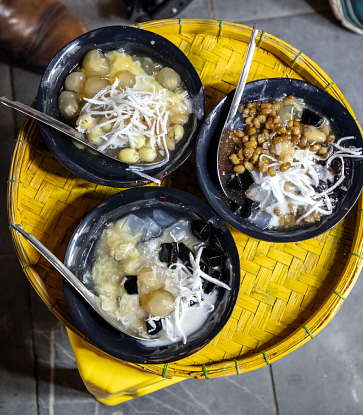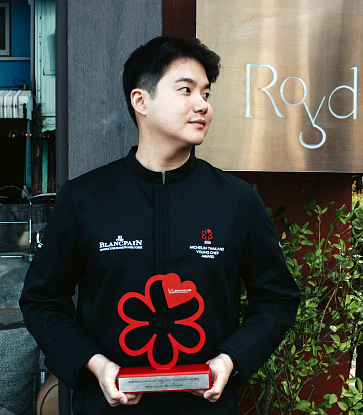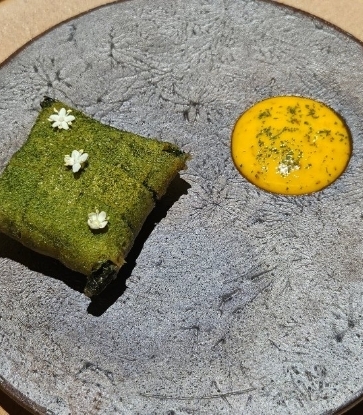When people think of Thai food, globally renowned dishes like Tom Yam Kung or Phad Thai often come to mind first. However, when it comes to the most affordable and accessible option, available on nearly every street corner, "Khao Kaeng" reigns supreme.
In the old days, Thai meals were typically served as a "samrub", consisting of rice and various accompanying dishes, all enjoyed in the comfort of home. However, with changing lifestyles and cultural shifts, people began spending more time outside and eating out more frequently. As a result, samrub evolved into “Khao Kaeng,” a convenient meal of rice topped with curries and other toppings. This affordable, quick meal became a staple for every social class. Yet, despite its ubiquity, “Khao Kaeng” is often taken for granted and rarely celebrated.
At the MICHELIN Guide Ceremony Thailand 2024, Wana Yook was awarded one MICHELIN Star for redefining the boundaries of “Khao Kaeng”. Today, we speak with Chef Chalee Kader about how his contemporary Thai restaurant earned this prestigious accolade by transforming a simple, quick meal into a fine dining experience that tells the stories of local ingredients to its customers.
Chef Kader, the son of a Chinese mother and an Indian father, was born and raised in Thailand. He spent time in kitchens from a young age but became serious about cooking while studying in the US. Upon returning to Thailand, he worked for a food importer and served as a chef at the Embassy of France in Bangkok for six years. He then left to pursue his own dream of running restaurants.
Kader’s current portfolio includes the contemporary Northeastern restaurant 100 Mahaseth (Bib Gourmand, MICHELIN Guide Thailand 2024) and the contemporary Thai restaurant Wana Yook (One MICHELIN Star, MICHELIN Guide Thailand 2024). The MICHELIN-Starred Wana Yook reflects the diverse lifestyles of people across the social spectrum, much like the different tones in the Thai language, all united by their love for Khao Kaeng.
“At first, people around me were concerned about whether the simple concept of Khao Kaeng would take off. But I wanted to give it a try.”

From a quick meal to fine dining
“I love eating Khao Kaeng. When you order different dishes that complement each other, every bite offers different dimensions of taste. I’ve noticed that everyone saves a particular topping for their last bite, making it the most intriguing moment. The combination of dishes reflects personal preferences. That, along with the growing difficulty of finding good Khao Kaeng places, sparked the idea for Wana Yook.
"At first, people around me were concerned about whether the simple concept of Khao Kaeng would take off. But I wanted to give it a try. I always tell my kitchen team that we’ll use contemporary and international techniques to make Thai food more interesting. Despite our unconventional presentation, we will never lose the authentic taste of Thai cuisine. That’s the most important thing."

Khao Kaeng in a century-old colonial house
A white colonial house nestled within the 515 Victory Community Space has been renovated, yet it retains its classic charm. Situated at the heart of the Victory Monument neighbourhood, Wana Yook is elegantly illuminated. Kader explains that the house was constructed towards the end of King Rama VII’s reign, around 80 to 100 years ago.
Wana Yook opened its doors about three years ago, at the close of the COVID-19 pandemic.
Wana Yook’s tasting menu begins with 4 to 5 courses that can be combined into a single dish or enjoyed in one bite. The main course features a selection of Khao Kaeng dishes and rice from various regions of Thailand.
“Wana Yook’s menus rotate seasonally, changing every 3 to 4 months. The latest tasting menu highlights the bold flavours of Southern Khao Kaeng. The set includes Kaeng Sab Nok (minced meat curry), Yam Nua Yang (spicy grilled beef salad), and Kaeng Jued Saku Dok Kajon (sago and cowslip creeper clear soup) served with a fried egg. We also offer Bai Liang Tom Kati (Melindjo leaves in coconut milk soup),” says the chef.

Thailand’s finest on display
One of Wana Yook’s highlights is their presentation of rice from across Thailand, allowing you to experience a variety of tastes and textures along with their origin stories. The restaurant sources the best ingredients from each region, such as Samut Sakhon’s krill paste and fresh fish from the south, which are delivered daily to their kitchen. They also feature GI (Geographical Indication) products, which embody local wisdom and regional identities, including Jasmine Rice 105 from Thung Kula Rong-Hai, Sisaket Garlic, Buriram’s jasmine volcanic rice, and Sakon Nakhon’s Pon Yang Kham beef. These ingredients showcase the rich abundance of Thailand’s culinary heritage.

“There are reasons behind our commitment to local ingredients,” says Kader. “For example, we aim to feature different rice varieties in each course and season. We want our customers to experience something beyond the familiar jasmine rice. Some rice varieties offer unique tastes and textures but are not widely known. By showcasing them, we help preserve these varieties from becoming extinct and contribute to natural diversity. We also source high-quality produce from dedicated farmers across Thailand.”
With its concept of elevating Khao Kaeng and a selection of the finest ingredients, Wana Yook offers food lovers a refreshing experience. It’s no surprise that the restaurant has earned a MICHELIN Star. Chef Kader shares his thoughts on this prestigious recognition.
“I’m so glad and proud,” reveals the chef. “Although 100 Mahaseth received a Bib Gourmand several years ago, this is the first time we’ve earned a Star. This recognition is proof of and a reward for the effort that my team and I have invested in Wana Yook,” Kader’s tenacious and firm belief is a force to be reckoned with to success. “As I mentioned before, not everyone believed this concept would succeed, but we remained committed to it. For us, Khao Kaeng is a unique aspect of Thai culture that truly deserves to be celebrated.”
“Khao Kaeng has always been a part of Thai life. It reflects the changing social contexts from the past to the present. I want to see Thai people feel prouder and more appreciative of our Khao Kaeng culture.”

So, why should everyone try Khao Kaeng?
What is Khao Kaeng like? A MICHELIN Star takes the Thai meal set to a whole new level. The chef is eager for you to dive into and savour Thailand’s lively quick meal scene.
“Khao Kaeng has always been a part of Thai life. It reflects the changing social contexts from the past to the present. Thai people are familiar with it, especially those in the central and southern regions where it is more distinctive,” the chef shares. “I want to see Thai people feel prouder and more appreciative of our Khao Kaeng culture. It is something that every social class has in common. I encourage visitors to explore Khao Kaeng shops or stalls. And if you wish to delve deeper into Khao Kaeng, Wana Yook is ready to welcome you.”
Planning to visit Thailand soon? Don’t forget to add Khao Kaeng to your itinerary. Book a table at Wana Yook if you want to enhance your experience with stories and carefully selected ingredients. For updates on travel destinations, contact the TAT Call Centre at 1672 or visit their Facebook page, TAT Contact Centre.




















